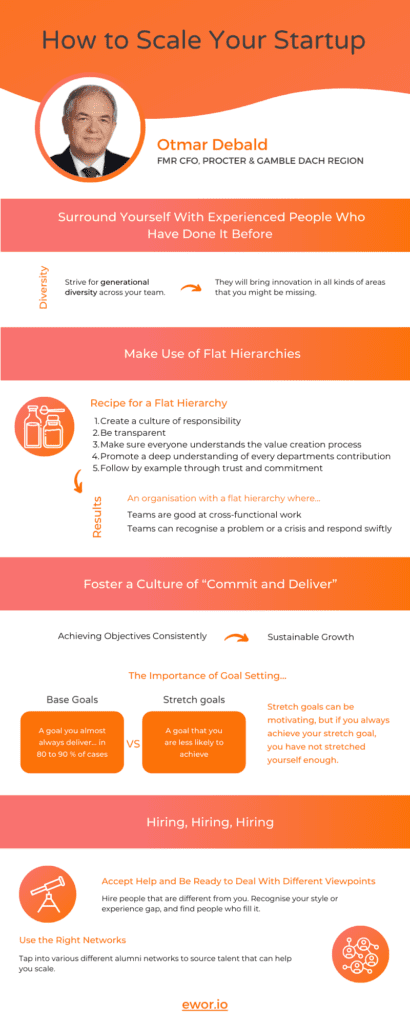To build and scale a start-up that lasts forever is a fascinating and complex task.
Few corporations have proven that they can continuously reinvent themselves and go on forever like a perpetual motion machine, a continually moving structure that generates at least as much energy as it absorbs.
Investors assign an enormous premium to organisations that have already proven that they can grow sustainably. So what does it take to build and scale a start-up that lasts?
Let us look at the best example first, one that I know well from the inside: P&G.
When I started my 33+ years career at P&G in 1979, it was already long considered one of the leading corporations of the world. It was constantly reinventing itself. Now, in 2021, 184 years after it was created as a little candle making start-up in the US, it is still one of the leading corporations of the world.
While I have a good understanding of the design elements that got P&G to that historical success, I do not want to talk too much about them today. The company is very good telling that story itself … and as a start-up entrepreneur, you might be far from the size of a corporate giant. If you want to learn about P&G, read some articles and books about it.
Instead, I want to talk about what a scaling or maturing start-up must do to grow sustainably. What you must consider to take the next step.
How do you get out of the garage mode of a start-up to become the next blue chip, the next P&G, the next Amazon, or the next Zalando?
For the past eight years I have worked as an Angel, Advisor or Chairman to start-ups of all sizes and scaling stages. There are a few common principles that I would like to share to help you scale yours.
Surround Yourself with Experienced People Who Have Done It Before
Bring together a group of diverse people who only accept the sky as the limit. You can then work magic to scale a start-up.
Diversity is the secret to success. It has many aspects; gender, culture, style and knowledge, to name a few.
Generational diversity is one aspect of it.
By that, I do not mean just bringing old people to work with young people. As you scale your start-up, you will realise that you need to develop recurring processes. That doesn’t just mean transactional processes; it also includes the process of innovation, the core process of reinventing a company.
People often think about innovation as inventing products, technology or anything in their core value creation process. Innovation can also be in the way you generate ideas, the way you interact with your consumers, how you apply data or the way you recruit people.
Get the right people into your team that have the experience you do not possess yet. They will bring innovation in all kinds of areas that you might be missing.
Be careful though of which kind of experience you acquire. There are too many old folks around who missed the train, do not know what tech is all about, and have a “my way or the highway”-attitude.
Look for experienced people who never lost their curiosity to learn. Find experienced people who want to learn from you.
I am a strong believer in reverse mentoring. Any mentor should come with the attitude that he or she wants to learn from you as well. A mentor is not just a teacher anymore. Mentoring today is a two-way street.
In any case, magic is created when start-ups find the right experienced leaders to scale their business model.
Make Use of Flat Hierarchies
When scaling an organisation, you often add a lot of people in a short period of time. You need to find a way to get them onboard quickly and choose how decisions get made.
In the old world, we had “top-down” chains of command. Employees looked at their formal bosses to give them direction and decide for them. Disagreements with other functions were handled through hierarchy.
This neither works in today’s world, nor is it appealing to most young people, nor does it produce superior results. Flat hierarchies make more sense.
A responsive organisation has self-organising teams. That sounds easy, but in reality it is far more difficult to design. It requires a much higher sense of responsibility and urgency for everyone, and it requires far more transparency within the whole company. That begins with deploying the strategy to literally every single employee.
Everyone must understand what the company is aiming for and how it intends to create value. It is not enough to tell your employees what they must do in their functional role.
Everyone must understand the company’s value creation process and their individual role within that. Even that is not enough, though. There should be a good understanding of how other departments contribute to the company’s goals.
Organisations with flat hierarchies must be extremely good at cross-functional work. Everyone must be able to recognise a problem or a crisis, and everyone must have the ownership and the ability to handle problems.
Foster a Culture of “Commit and Deliver”
To create an organisation that delivers sustainable growth means to create an organisation that achieves its objectives consistently.
In the maturing stage of your company, your investors want to see the return you promised them. Hence, you have to learn to make plans that become reality. This is awfully difficult for many start-ups.
In the seed and early-stage phases, you were used to an entrepreneurial style, a “trial and error” process, and a risk-taking attitude that got you where you are now.
Now, as a leader, you need to find a way to keep the entrepreneurial style while making plans that have a high probability to deliver the numbers you planned for, with an organisation that is so big you cannot sense what is going on anymore.
That is a dangerous phase where many start-ups fail.
You will find many “post-IPO” companies that ended up with disappointing results because they did not deliver what they promised to their shareholders.
The reason is often a failed planning culture. People get rewarded for promises, for being bold, for stretching goals. I myself love stretch goals, but the difference with a “base goal” must be very clear.
A base goal is something you almost always deliver… in 80 to 90 % of cases. A stretch goal can be motivating, but if you always achieve your stretch goal, you have not stretched yourself enough.
In your company’s maturity or growth stage, everyone must adopt a “commit and deliver” attitude. All your people, at all levels, must consider a base goal a commitment that is far more than a promise.
And they must do whatever it takes to achieve it.
For this to work, everyone must understand the company’s whole value creation process. They must be able to sense a problem that has an impact on their ability to deliver on the commitment, and be empowered to act upon deviations from the path to achieve that goal.
There is a danger though that “commit and deliver” results in “low balling” or “sand bagging”, i.e. goals that are far too low. This is where stretch goals come in. Everyone should have a stretch goal and should also be evaluated based on its degree of achievement too.
Accept Help and Be Ready to Deal with Different Viewpoints
The most difficult task for a leader is to hire someone who is very different from them and to let someone who you like go.
Some of my most productive relationships are with people I often disagree with. As long as there is a common base of values, the arguing is more than ok, it’s productive.
If you surround yourself with people who can finish all your sentences, you have a team that will fail. Find people who have a very different style from yours.
That requires an honest assessment of yourself. I strongly recommend you go through a coaching process to you assess your style.
Myers-Briggs type indicators are very good, as is Strength Finder. Be honest with yourself, recognise your style or experience gap, and find people who fill it.
Most founders I met are strong minds, independent people who are not willing to accept the status-quo. They have built a successful start-up because of that, not in spite of it. There comes a point though, when that is not the only skill required anymore.
Use the Right Networks for Hiring to Scale a Start-Up
You will need more people, people you do not have and people you do not know yet. So, how do you find them?
Professional networks are very helpful here. Tapping into them can be inefficient, however. Building a LinkedIn network by just connecting with who you think are the right people is far too time-consuming.
Depending on the industry and field you are in, look out for industry-specific networks. In Consumer Goods for example, the P&G Alumni network is by far the most powerful business network. Try to find someone with a P&G background who is active in that network.
Consulting firms such as McKinsey, BCG or Bain have very powerful alumni networks, too. There, you will find people who are familiar with your industry.
Connecting through entrepreneur networks works much better. You are already connected to EWOR. This is one of the best entrepreneurial platforms where you can find help to scale your business.
If you liked this article feel free to connect to Otmar on LinkedIn
Did you like the post? If you want to leave a comment or ask a question feel free to do so here


